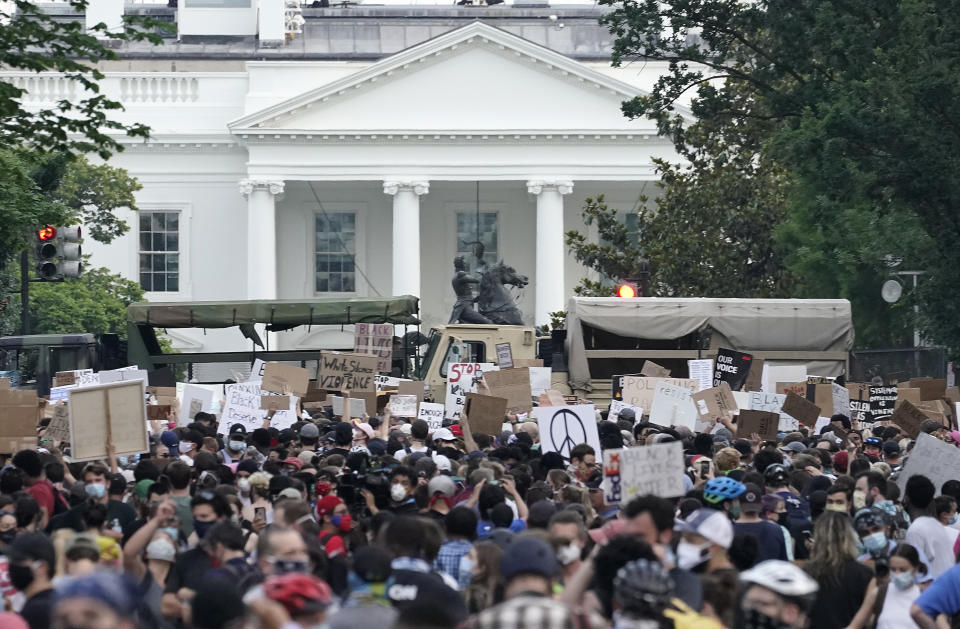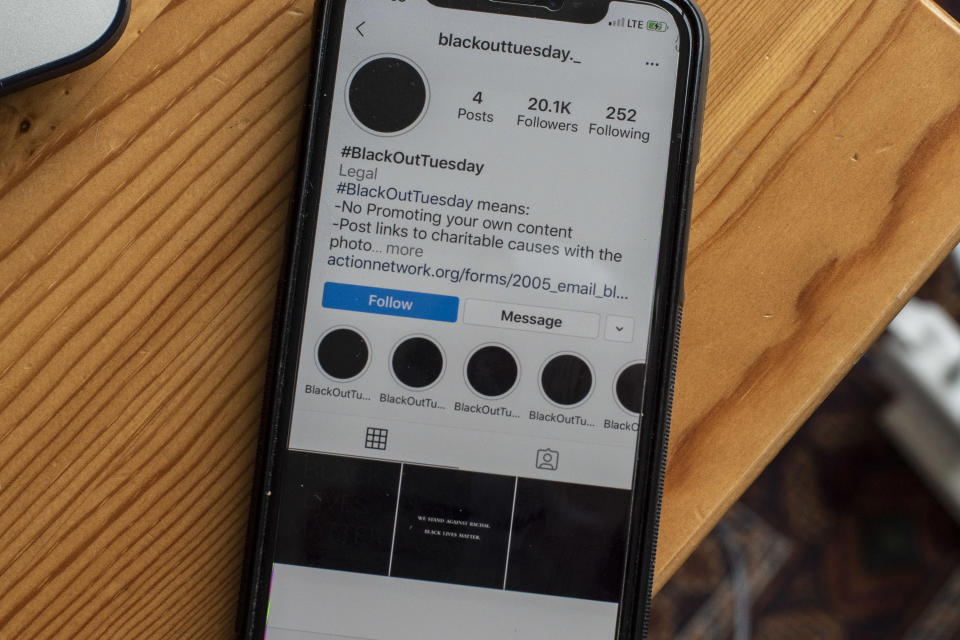Floyd protests and Trump's response gave Washington a week it won't soon forget
WASHINGTON — It became clear during the late night hours of Friday, May 29, that there was something different about the demonstrations of the police killing of an African-American man than the ones that had taken place in recent years. A group of protesters breached the barricades that stood between the White House and Lafayette Park, leading to an hours-long standoff just outside the West Wing. Enraged protesters battled Secret Service agents dressed black riot gear and carrying plastic shields, a scene that few Americans had ever witnessed in this nation, much less at the president’s doorstep.
After midnight, the crowd managed to pull two officers off the line, dragging them into the park, fists flying. The wild spectacle of street fighting steps from 1600 Pennsylvania Ave. was just as unprecedented as what was transpiring inside the White House, where the president was informed of the chaos and, out of a concern for his safety, he and his family were led into a fortified underground bunker.
Firing pepper spray, swinging batons and shouting “get the f*** out of the park,” federal agents were eventually able to turn back the demonstrators.
But that startling, surreal clash would not be the last in Washington spurred by the killing of George Floyd. Once the crowds were cleared from Lafayette Park, fortifications were hardened and National Guard reinforcements with riot shields joined the line of defense walling off the park. Crowds of protesters surged into the city on Saturday and Sunday, lighting fires after dark and tearing through multiple stores. The violence mainly focused in the downtown business district, but there were pockets of looting that spread to residential neighborhoods, leading D.C. Mayor Muriel Bowser to order an 11 p.m. curfew on Sunday.

By Monday, troops patrolled the streets along with heavily armed officers from the alphabet soup of federal agencies; ATF, DEA, FBI, SORT teams from the BOP, etc. The nation’s capital, it seemed, was a city under siege.
As it became clear that the protesters chanting “Black lives matter!” and “No justice! No peace!” would not, to paraphrase the president’s early prediction for the coronavirus pandemic, “magically disappear,” Browser on Monday moved up the curfew four hours earlier, to 7 p.m.
Twenty minutes before that hour arrived on Monday night, with the president still due to deliver remarks on the protests from the White House Rose Garden, a series of loud crashes ripped through Lafayette Park. Flash-bang grenades fired by the U.S. Park Police paved the way for a phalanx of officers on horseback and others on foot dressed in black riot gear.
“Move! Move! Move!” they barked in military unison at the hundreds of protesters gathered within shouting distance of the White House. With National Guard helicopters hovering overhead, demonstrators bolted as the officers descended upon them, some hurling insults as they were chased.

Volleys of rubber bullets and tear gas canisters hit the crowd. Yellow-and-white clouds billowed in the center of the street as the protesters scrambled away. Roughly 15 minutes later, with stinging fumes still wafting through the air, Trump had delivered his brief statement, stepped out of the White House and strode through the park for a photo op at St. John’s Church, which had been set on fire during the chaos on Sunday night. Trump was accompanied by an entourage that included Attorney General William Barr, Defense Secretary Mark Esper, and his daughter, Ivanka, who reached into her $1,540 purse and handed him a Bible. As sirens wailed and cameras clicked, Trump held the holy book aloft and pumped it in the air.
“We have a great country. That’s my thoughts,” the president said.
Barr, it was later revealed, had ordered the dispersal of the protesters that day, though he claimed on Thursday that he made the decision prior to learning about the president’s high-profile trip to the church.
Reporters covering the clash, protesters and Episcopal Bishop Mariann Budde concurred that the Park Police had used tear gas on the demonstrators, but the White House and Trump’s conservative allies suggested that specific chemical agent had not been deployed against the crowds, a claim which has been debunked by experts. Eventually, on Friday, U.S. Park Police spokesperson Sgt. Eduardo Delgado admitted it was a “mistake” for the agency to have said they didn’t use tear gas.
Saying he was “angry and appalled” at Trump’s response to the protests, former Defense Secretary James Mattis said his former boss was seeking “to divide” Americans.
In response, Trump tweeted a letter written by Washington lawyer John Dowd rebuking Mattis and describing the protesters as “phony.”

But the Trump administration wasn’t the only source of questionable claims during the days of protests. On Twitter, hashtags spread like wildfire on Sunday evening, boosting such misinformation as claims that D.C. lines of communication had been cut because activists had been murdered en masse, or that some government buildings had been burned down. None of it was true, but the false stories — and ensuing panic — spread into Monday morning. A spokesperson for Twitter later said it was clear the hoax came from some type of organized campaign.
“We are actively investigating the hashtag #dcblackout and during that process have already suspended hundreds of spammy accounts that tweeted using the hashtag,” the spokesperson said.
Echoing the statements of mayors and governors about the influence of “outsiders,” peaceful demonstrators expressed fears that agitators — including anarchists, criminal looters and white supremacists — had infiltrated the protests with the intent of inciting violence.
In Santa Clarita, Calif., a bomb squad removed a dangerous device that was planted at the site of a protest on Thursday. At multiple protests around the country, including in Washington, there has been evidence that some attendees were followers of the “boogaloo” movement, a far-right, antigovernment amalgam dedicated to fomenting civil war and racial conflict. On Wednesday, NBC News reported three male “boogaloo” adherents were charged after conspiring to “incite a riot” and deploy Molotov cocktails at a Las Vegas protest over Floyd’s death.
Back in Lafayette Park on Wednesday, protesters taped up a sign that read “BOOGALOO BOIS GO HOME.”

In part, the protests have been fertile ground for violence because they are infused with anger. And that rage is not limited to Floyd’s May 25 death. Demonstrators have also increasingly tried to focus the movement on Breonna Taylor, an African-American woman who was killed in her home in March as police burst in to conduct an investigation. Taylor’s death occurred just as the coronavirus pandemic was intensifying around the world and it has, thus far, been less high-profile than Floyd’s killing. But the palpable sense of indignation over the deaths of Floyd and Taylor was also kindled by the police killings of Eric Garner, Philando Castile and Walter Scott, to say nothing of the numerous police killings of unarmed African-Americans before the age of cellphone video.
“We’re seeing so many videos, so many new names daily that we’re also forgetting that there are so many more that we don’t see that are not recorded,” Aalayah Eastmond, a 19-year-old organizer with Concerned Citizens, told Yahoo News.
Almost an afterthought over the past week has been the question of whether the crowded demonstrations that have overtaken American streets will result in a second major outbreak of coronavirus cases. That fear came to the fore on Tuesday evening when officers from the Bureau of Alcohol, Tobacco, Firearms and Explosives briefly took a man into custody who was in respiratory distress. As bystanders observed the situation the officers inquired whether anyone had an inhaler. They kept the man handcuffed as he wheezed while lying on the ground. The ATF officers declined to answer questions about why the man was being detained and why he was cuffed while in distress. Only after the Fire Department arrived at the scene was the man freed from his handcuffs and given medical aid.

While many of the protesters in D.C. have been wearing masks to ward off the coronavirus, the vast majority of law enforcement do not. Unlike the ATF agents who detained the protester on Tuesday, the firefighters who arrived and gave him oxygen wore gowns, masks and face shields to deal with the high-risk patient.
While many protesters told Yahoo News that they are concerned about the coronavirus, they were quick to add that it’s more important to be out in the streets.
“Right now I’m worried about my future kids, my future people in the world,” an African-American protester named Lindsay said as she watched firefighters tend to the arrested protester.
As the week wore on, a relative calm descended upon Lafayette Park. In place of the rioters, groups have emerged aiming to focus the protests on policy goals. The Concerned Citizens debuted with a list of demands for the protests on Wednesday. While they don’t explicitly denounce violent protests, the group’s leaders, including Eastmond, say they are focused on peaceful actions.

“We’ve been on the front lines of the protests,” Eastmond said. “We see the chanting … we see a lot of people with just the question of, ‘What’s next?’”
That’s the same question that seems to be on everyone’s lips as a wary — and frankly weary — nation looks to move beyond crisis mode. While massive demonstrations are expected this weekend in the nation’s capital, Trump appears to be busy fortifying the White House. New fences were erected this week, forming an expanded perimeter with multiple layers of chain link, concrete blocks and approximately 1,300 personnel from various agencies. The president also canceled a trip to his New Jersey golf club that was planned for this weekend.
But the government has also taken steps to deescalate tensions with the protesters. Notably, D.C. has lifted its curfew, meaning demonstrators who stay in the streets at night aren’t subject to arrests. And there hasn’t been any major aggressive enforcement since the park was cleared on Monday.
Whatever does happen next, one thing is clear: Washington has never seen a week like this one.
Cover thumbnail photo: Alex Wong/Getty Images
_____
Read more:


